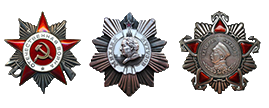Михаил Барятинский — Лёгкий танк Pz.38(t)

Pz.38(t) имел очевидное преимущество перед всеми советскими танками начала Великой Отечественной войны по количеству и качеству приборов наблюдения. Командирская башенка с четырьмя эпископами позволяла вести круговое наблюдение за местностью.
Правильность последнего утверждения можно проиллюстрировать на следующем примере. 24 июня 1941 года экипаж танка БТ-7 5-й советской танковой дивизии в составе старшего сержанта Найдина и красноармейца Копытова уничтожил 12 немецких танков! Обнаружив вражескую колонну, они замаскировали в лесу свою машину. Подпустив танки противника поближе, советские танкисты подбили головную машину, а затем замыкающую. Пользуясь замешательством врага, неожиданно попавшего под обстрел, экипаж БТ-7 (что важно — неполный экипаж!) расстрелял остальные 10 танков. В описании этого боя, хранящегося в Центральном архиве Министерства обороны, не указан тип вражеских танков. Но, как известно, 5-я советская танковая дивизия сражалась с 7-й танковой дивизией Вермахта, укомплектованной на 65 % машинами Pz.38(t), так что и вероятность участия их в этом бою такая же.
В целом же Pz.38(t), как более современный танк, имел некоторое преимущество перед БТ-7 и Т-26. Сравнение с Т-34 будет некорректным — это машина не только другого класса, но и другой концепции. Следует, однако, подчеркнуть, что при неграмотном командовании и в руках неподготовленного экипажа и Т-34 мог стать лёгкой добычей для Pz.38(t)!

Лёгкий танк Pz.38(t) Ausf.G во время Великой Отечественной войны проходил испытания на НИБТПолигоне. Это фото сделано в 1946 году, но сам танк находится в экспозиции Военно-исторического музея бронетанкового вооружения и техники в Кубинке до сегодняшних дней.
Суммируя вышесказанное, по мнению автора, можно утверждать, что LT vz.38 был не только лучшим чехословацким лёгким танком 1930-х годов, но и одним из лучших в классе «лёгких-средних». Правда, с его созданием чехословацкие конструкторы несколько припозднились, не уловили перспективных тенденций танкостроения. Впрочем, не только они одни — Вторая мировая война поставила крест на всех «лёгких-средних» танках.
ЛИТЕРАТУРА
1. Барятинский М. Бронетанковая техника стран Европы 1939–1945. — М., «Моделист-конструктор», 1999.
2. Барятинский М. Бронетанковая техника Третьего рейха. — М., «Моделист-конструктор», 2002.
3. Карель П. Восточный фронт. — М., «Изографус», «Эксмо», 2003.
4. Коломиец М. 1941: бои в Прибалтике. — М., «Стратегия КМ», 2002.
5. Коломиец М. Битва за Москву. — М., «Стратегия КМ», 2002.
6. С. К. Kliment, V. Francev. Czechoslovak Armored Fighting Vehicles 1918–1948. — Schiffer Publishing Ltd., 1997.
7. J. Ledwoch. Pz.38(t). LT vz.38. -Wydawnictwo Militaria, 1993.
8. J. Ledwoch. Pz.Kpfw.II Luchs, Aufklärungspanzer 38(t) — Wydawnictwo Militaria, 2000.
9. C. K. Kliment, H. L. Doyle. Pz.Kpfw.38(t) in action. — Squadron/Signal Pupblications, 1979.
10. Thomas L. Jents. Panzertruppen 1935–1945. — Schiffer Publishing Ltd, 1996.
Журналы: «Моделист-конструктор», «Бронеколлекция», «Танкомастер», ATOM, НРМ.
ИЛЛЮСТРАЦИИ

Pz.38(t) Ausf.A. 3-я рота 67-го танкового батальона 3-й лёгкой дивизии. Польша, сентябрь 1939 г.

Pz.38(t) Ausf.C. 25-й танковый полк 7-й танковой дивизии. Франция, май 1940 г.

Pz.38(t) Ausf.C. 3-й батальон 10-го танкового полка 8-й танковой дивизии. Восточный фронт, август 1941 г.

LT vz.40. «Быстрая группа» словацкого армейского корпуса Украина, 1941 г.

Strv m/41 SI. 3-й танковый Содерманландский полк. Швеция, 1942 г.

Лёгкий танк «Прага». 9-я рота болгарской танковой бригады. София, январь 1945 г.

Pz.38(t) Ausf.C. 21-й танковый полк 20-й танковой дивизии. Восточный фронт, 1941 г.

Aufklärungspanzer 38(t). 2-я танковая дивизия, Западный фронт, лето 1944 г.

Pz.38(t) Ausf.G. 204-й танковый полк 22-й танковой дивизии. Восточный фронт, Крым, 1942 г.
profilib.org
РАЗВЕДЫВАТЕЛЬНЫЕ ТАНКИ НА БАЗЕ Pz.38(t). Лёгкий танк Pz.38(t)
РАЗВЕДЫВАТЕЛЬНЫЕ ТАНКИ НА БАЗЕ Pz.38(t)
Praga TNHnA
С начала Второй мировой войны Панцерваффе испытывали острую потребность в специализированном разведывательном танке. Поэтому уже 15 сентября 1939 года Управление вооружений Вермахта начало проработку этого вопроса. Летом 1940 года трём компаниям — ВММ, ?koda и MAN — выдали техзадания на проектирование. Новый танк должен был иметь массу 12–13 т и скорость 50 км/ч. Толщина лобовой брони предусматривалась до 30 мм, бортовой — 20 мм. Вооружение: 20-мм или 37-мм пушка и пулемёт.
В октябре 1940 года фирма ВММ изготовила деревянный макет, а в период с ноября 1941-го по апрель 1942 года — пять прототипов: два из простой стали, с клёпаным и сварным корпусами; три — из броневой, один клёпаный и два сварных. Танк TNHnA получил усовершенствованную башню с «казематом» на крыше, в котором имелись четыре смотровых прибора, обеспечивавших хороший обзор поля боя вперёд и назад. Ещё два прибора наблюдения находились в бортах башни. По сравнению с базовым Pz.38(t), была модернизирована и ходовая часть: теперь она включала в себя опорные катки диаметром 810 мм вместо 775 мм. На танке установили новый V-образный 8-цилиндровый карбюраторный двигатель жидкостного охлаждения Praga NR мощностью 248 л. с. при 2500 об/мин, разгонявший 11,8-т боевую машину до скорости 64 км/ч. Запас хода составлял 200 км. Всё вооружение танка — 37-мм пушка ?koda А19 и пулемёт MG 34 — размещалось в башне. Боекомплект состоял из 90 выстрелов и 700 патронов. Экипаж машины — 4 человека.
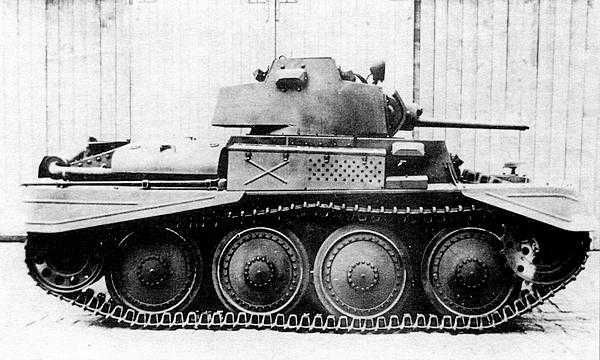
Разведывательный танк TNHnA во дворе фирмы ВММ. 1941 год.
Летом 1942 года прототипы ВММ и других фирм отправили на Куммерсдорфский полигон. В октябре там прошли сравнительные испытания танков TNHnA, Т-15 фирмы ?koda и VK1303 фирмы MAN. В ходе этих испытаний TNHnA, например, прошёл 338 км за 9 часов, и вполне успешно. Но военным больше приглянулся VK1303 — будущий Pz.IIL Luchs (см. «Бронеколлекцию» № 4 за 2002 г.).
Оставшиеся не у дел TNHnA (или Pz.38(t) nA) послужили базой для создания весьма интересной боевой машины. В 1943 году Управление вооружений заказало фирме ВММ два прототипа гусеничного разведчика K?tzchen («Кетцхен» — «котёнок»). Один из них был оснащён дизелем Tatra 103 мощностью 220 л. с., другой бензомотором Praga NR. По сути «Кетцхен» представлял собой гусеничный бронетранспортёр. Его корпус был сварен из бронелистов толщиной 20–50 мм, расположенных под рациональными углами наклона. Крыши корпус не имел. В его кормовой части справа располагался двигатель. В задней стенке десантного отсека, вмещавшего 6–8 пехотинцев, слева от двигателя находилась двухстворчатая дверь. Вооружение состояло из двух пулемётов MG 34 на вертлюжных установках. Масса «котёнка» составляла 10,5 т.

Прототип разведывательного танка TNHnA на заводской территории фирмы ВММ в Праге. 1943 год.
Прототипы изготовили в 1944 году. На испытаниях они развили скорость до 64 км/ч. При этом запас хода у машины с дизелем достиг 600 км. Несмотря на успешные испытания, серийный выпуск бронетранспортёра так и не был начат. Дальнейшая судьба прототипов не известна.
Ещё один прототип TNHnA уже после войны послужил для испытаний «шкодовских» 47-мм и 57-мм пушек, а в 1950-х годах был разделан на металлолом.

Компоновка танка TNHnA.
Aufkl?rungspanzer 38(t) Sd.Kfz.140/1
Летом 1943 года конструкторское бюро фирмы ВММ приступило к проектированию ещё одного разведчика — машины, вооружённой 20-мм автоматической пушкой KwK 38 и спаренным с ней пулемётом или 75-мм гаубицей К51. Установка вооружения должна была быть унифицирована с таковой у бронеавтомобилей Sd.Kfz.234/4 и Sd.Kfz.234/3. Заказом предусматривалось изготовление прототипа и трёх машин для испытаний. Первоначально ВММ планировала использовать шасси танка TNHnA, однако это оказалось нереальным — танк и многие его агрегаты не производились серийно, что серьёзно тормозило работу. Поэтому пришлось вернуться к отработанному шасси Pz.38(t). В сентябре 1943-го на фирме ВММ изготовили два деревянных макета: один с 20-мм пушкой, другой — с 75-мм гаубицей. Зимой 1944 года прототип и три предсерийные машины уже проходили испытания. У первого была сварная подбашенная коробка, у остальных — клёпаные. Все они собирались из бронелистов толщиной 10 и 15 мм. При этом башни и вооружение отсутствовали, а их место заняли балластные макеты. Использование двигателя Praga АЕ мощностью 160 л. с. при 2600 об/мин привело к изменениям в системе выхлопа. В отличие от Praga АС, на этом моторе выхлопной коллектор выводился вверх, поэтому пришлось удлинить выхлопную трубу и поднять глушитель почти на крышу силового отделения.
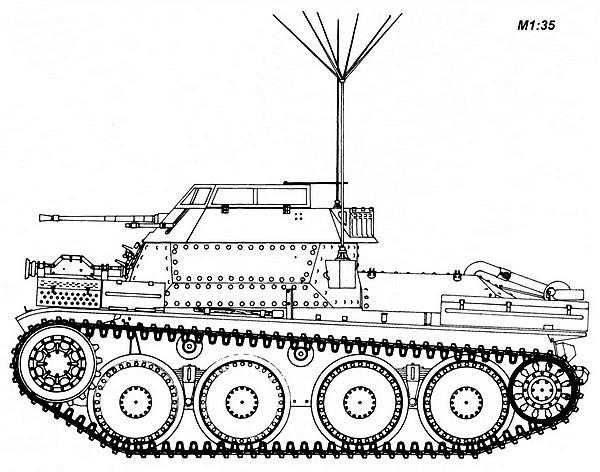
Aufkl?rungspanzer 38(t)

Вид на боевое отделение разведывательного танка Aufkl?rungspanzer 38(t). Хорошо виден лафет вооружения с 20-мм пушкой KwK 38 в центре, пулемётом MG 34 слева и прицелом TZF 3а справа. Откидная сетчатая крыша защищала боевое отделение от ручных гранат.
В открытой сверху многогранной башне была установлена 20-мм автоматическая пушка KwK 38 и спаренный с ней 7,92-мм пулемёт MG 42. Спаренная установка позволяла вести огонь по воздушным целям (угол возвышения колебался в пределах от -4° до +70°). Боекомплект состоял из 300 артвыстрелов и 1500 патронов. Для зашиты от ручных гранат сверху башня прикрывалась откидным двухстворчатым экраном из стальной сетки. Башня с вооружением комплектно поставлялась фирмой Appelt.
После принятия на вооружение разведывательный танк получил обозначение Aufkl?rungspanzer 38(t) (или Aufkl?rer 38(t)) и индекс Sd.Kfz.140/1. Боевых машин этого типа выпустили совсем не много: в феврале 1944 года — 37 единиц и в марте — 33. При изготовлении танков использовались шасси Pz.38(t) 10-й серии — Ausf.М.
Aufkl?rungspanzer 38(t) поступили на вооружение нескольких танковых дивизий, в том числе — 2-й танковой, действовавшей на Западном фронте. Несколько таких машин стали трофеями союзнических войск.


Серийный Aufkl?rungspanzer 38(t) во дворе завода BMM в Праге.
Поделитесь на страничкеmilitary.wikireading.ru
Pz.Kpfw.38 (t). Бронетанковая техника Германии 1939-1945
Лёгкий танк, разработанный фирмой ?KD для чехословацкой армии в 1938 году в развитие конструкций танков TNH, LTP и LTH, поставлявшихся на экспорт. Получил, армейское обозначение LT vz.38. Серийное производство началось только в 1939 году уже после немецкой оккупации. С 1939 по 1942 год заводами BMM (B?hmisch — M?hrische — Maschinenfabrik) — такое название получила фирма ?KD — было выпущено более 1300 танков Pz.Kpfw.38 (t).
СЕРИЙНЫЕ МОДИФИКАЦИИ:
Pz.Kpfw.38 (t) Ausf.A — танки полностью идентичные тем, что предназначались для чехословацкой армии. Двигатель Praga EPA мощностью 125 л.с. Вооружение: 37-мм пушка и два пулемёта. Бронирование 10–25 мм. Танк имел две антенны: штыревую и поручневую, закреплённую на левом борту корпуса. Изготовлено 150 единиц.
38 (t) В — ликвидирована поручневая антенна, установлена фара Notek. Изготовлено 110 единиц.
38 (t) С — чешская антенна заменена немецкой, введены другие мелкие изменения. Изготовлено 110 единиц.
38 (t) D — введён прямой лобовой лист корпуса. На части танков лобовая броня была доведена до 50 мм. Вооружение, двигатель, ходовая часть — без изменений. Изготовлено 105 единиц.
38 (t) E — вариант D с увеличенной толщиной брони (лоб корпуса и башни — 50 мм, борта корпуса и башни — 30 мм). Боевая масса 9,87 т. На левой надгусеничной полке смонтирован ящик ЗИП большого размера. Изготовлено 275 единиц.
38 (t) F — идентичен по конструкции варианту E. Изготовлено 250 единиц.
38 (t) G — последняя серийная модификация. От варианта E отличалась отсутствием ящика ЗИП. Изготовлено 324 единицы.
38 (t) S — экспортный вариант. По конструкции идентичен моделям А — С. Предназначался для Швеции, но поставлен не был. Изготовлено 90 единиц.

38 (t) В

38 (t) A

38 (t) G
Боевое крещение получили во время польской кампании, в которой участвовали 59 машин 38 (t) 67-го танкового батальона 3-й лёгкой дивизии вермахта.
К началу наступления на Францию они находились в строю уже двух танковых дивизий: 7-й и 8-й (соответственно 106 и 123 единицы).
На 22 июня 1941 года в пяти немецких танковых дивизиях первой линии имелось 623 танка 38 (t). Почти все они к концу года были потеряны. В начале 1942 года основная масса танков этого типа была объединена во вновь сформированную 22-ю танковую дивизию. Она воевала в Крыму, а затем в приволжских степях. В ноябре в ходе боёв в районе г. Калач-на-Дону дивизия была разгромлена. В 1943–1944 годах оставшиеся в строю танки 38 (t) использовались главным образом в полицейских и учебных целях.
Помимо Германии, 38 (t) состояли на вооружении армий Румынии, Словакии, Болгарии и Венгрии. В румынской армии эти танки прослужили до конца войны.
На базе 38 (t) строились самоходно-артиллерийские установки, командирские и разведывательные танки, тягачи для подвоза боеприпасов.
ТАКТИКО-ТЕХНИЧЕСКИЕ ХАРАКТЕРИСТИКИ ТАНКА Pz.Kpfw.38 (t) Ausf.B.
БОЕВАЯ МАССА, т: 9,7.
ЭКИПАЖ, чел.: 4.
ГАБАРИТНЫЕ РАЗМЕРЫ, мм: длина — 4610, ширина — 2135, высота — 2252, клиренс — 400.
ВООРУЖЕНИЕ: 1 пушка KwK A7 L/42 калибра 37 мм, два пулемёта MG 37 (t) калибра 7,92 мм.
БОЕКОМПЛЕКТ: 72 артвыстрела, 2700 патронов.
ПРИБОРЫ ПРИЦЕЛИВАНИЯ: телескопический прицел.
БРОНИРОВАНИЕ, мм: лоб корпуса — 25; борт — 15; корма — 12; крыша — 10; днище — 8; башня — 15–25.
ДВИГАТЕЛЬ: Praga EPA, 6-цилиндровый, карбюраторный, рядный, жидкостного охлаждения; мощность 125 л.с. (92 кВт) при 2000 об/мин, рабочий объём 7754 куб. см.
ТРАНСМИССИЯ: многодисковый главный фрикцион сухого трения, планетарная коробка передач (5+1), бортовые фрикционы, бортовые передачи.
ХОДОВАЯ ЧАСТЬ: четыре опорных катка на борт, подвешенных попарно на листовых рессорах, два поддерживающих катка, ведущее колесо переднего расположения; в каждой гусенице 93 трака шириной 293 мм.
СКОРОСТЬ МАКС., км/ч: 42.
ЗАПАС ХОДА, км: 230.
ПРЕОДОЛЕВАЕМЫЕ ПРЕПЯТСТВИЯ: угол подъёма, град. — 28,7; ширина рва, м — 2,1; высота стенки, м — 0,8; глубина брода, м — 0,8.
СРЕДСТВА СВЯЗИ: радиостанция Fu 5.
Поделитесь на страничкеСледующая глава >
tech.wikireading.ru
Гайд по Pz.38(t) Ausf. A в War Thunder
На повестке дня у нас танк первой эры немецкой ветки развития, который обделен вниманием многих танкистов, так как находится практически на тупиковой ветке развития. На данный момент — дальше, если идти по этой ветке, только еще один ЛТ и одна ПТ. Итак, встречаем — Pz.38(t) Ausf. A.
Характеристики Pz.38(t) Ausf. A
Сухие технические характеристики танка выглядят следующим образом: масса — 9,5 тонн, мощность двигателя — 125 лошадиных сил, максимальная скорость — 31 км/ч. Бронирование Pz.38(t) Ausf. A идентичное как в корпусе так и в башне и составляет 25 мм в лобовой проекции и по 15 мм в корме и по бортам танка. В роли орудия здесь выступает пушка — KwK38 калибром 37 мм и боезапасом — 90 снарядов. Вниз ствол опускается на 10 градусов, а поднимается на 25 градусов.
Плюсы и минусы Pz.38(t) Ausf. A
Танк не отличается какими-то выдающимися характеристиками или ярко выраженными особенностями. В частности у него посредственные маневренные качества — машина крайне неохотно набирает скорость, а до максимальной разгоняется только на длинных и прямых участках или с горы. На месте танк поворачивается крайне неохотно, да и на ходу очень тяжело отзывается на рычаги управления.
Отдельного внимания заслуживает скорость передвижения задним ходом, которая составляет всего лишь 4 км/ч.. То есть быстро откатиться после выстрела в укрытие не получится, и эта особенность Pz.38(t) Ausf. A сможет сыграть с вами в бою очень злую шутку.

Бронированием он тоже похвастаться не может, ведь даже резервный Pz.Kpfw. II Ausf. C имеет более серьезную защиту. И конечно же брони Pz.38(t) Ausf. A не хватает, чтобы выдержать множественные попадания вражеских снарядов. А бронелисты, расположенные без каких-либо рациональных углов наклона, только усугубляют положение, что не добавляет машине живучести.
Орудие Pz.38(t) Ausf. A
Орудие также преподносит массу сюрпризов. При столь маленьком калибре перезарядка составляет чуть более четырёх секунд, что больше чем у всех одноранговых противников почти на секунду, за исключением Т-28 и ЗИС-30. То есть, вступая в открытую перестрелку с противником, вы наносите ущерб самому себе больше, чем врагу.
Тактика использования Pz.38(t) Ausf. A
Но, вся теория озвученная выше, на деле оказывается нам на руку. Плохие скоростные показатели не позволяют нам занимать в первых рядах ключевые позиции, но, зато, к нашему приезду на передовую, вражеские силы будут уже скованы боем и отвлечены на союзников. Это позволит нам, не опасаясь за свою машину, реализовывать потенциал орудия, в боекомплекте которого находятся очень интересные боеприпасы. А именно топовые подкалиберные снаряды с пробитием 77 мм на дистанции 100 метров, которые отлично борются на средних и ближних дистанциях с самым опасным противником на первой эре — Т-50. Кстати, это относится и к Т-34, который также можно уничтожать в ближнем бою этими же снарядами. С остальными танками, которые не имеют брони, такие как БТ-7, Т-26, Т-28, ЗИС-30 — лучше всего справляются предтоповые каморные бронебойные снаряды. В большинстве случаев они уничтожают вышеперечисленные машины с одного-двух попаданий. Также необходимо отметить отличную баллистику полёта снарядов, благодаря которой можно свободно выцеливать уязвимые точки в броне вражеских танков.
В вопросе живучести машины тоже есть свои нюансы. Хоть брони по факту у танка и нет, но иногда получается вытанковать пару выстрелов, не получив при этом повреждений.
Экипаж Pz.38(t) Ausf. A состоит из 4-х человек, что затрудняет выведение его из строя, а, следовательно, повышает общую боевую эффективность танка.
Подведём небольшой итог. Машина достойная на своём уровне, может бороться со всеми противниками, имеет широкий спектр применения в бою, но при этом использовать её нужно с умом.
Предлагаем посмотреть видео гайд по Pz.38(t) Ausf. A, с конкретными примерами использования его в бою:
Особая благодарность Tredo за создание видео гайда.
Поделитесь информацией с друзьями:
warthunderous.ru
Jagdpanzer 38(t) Hetzer
Nazi Germany (1944)
Tank hunter – 2,827 built
Škoda’s tank hunter
When Nazi Germany ruthlessly seized the industrial jewels of Czechoslovakia prior to the war, it also acquired a treasure of tank manufacturing skills that was to provide the Nazi war machine with more than 5,000 extremely reliable tanks during the war. The whole family was derived from a single model: the Škoda/Praga Lt vz.38, or Panzer 38(t) in German service, a light tank which was used until 1943-44, but also gave birth to one of the most prolific German tank hunters of the war, the Jagdpanzer 38(t) or, as it is commonly known today, the Hetzer.
G13 modified to look like a Hetzer on display at the Overloon War Museum in the Netherlands.
Hello, dear reader! This article is in need of some care and attention and may contain errors or inaccuracies. If you spot anything out of place, please let us know!
Compared to this vehicle, 2nd/3rd generation tank hunters were based on mediums or heavy tank chassis. The nimblest of these was the StuG III Ausf.G, based on the now obsolescent Panzer III chassis. Light tanks had served to develop the first generation of tanks hunters, improvised in 1941-42 with bulky, tall superstructures, while the AT gun was just basically welded on. But, overall, the main goal of this new tank hunter was to be readily available in larger quantities, cheaper, and with a proven chassis to avoid the problems observed with the more ambitious and complex designs derived from the “big cats”.
The very reliable Panzer 38(t) chassis already served as a basis for the prolific Marder III, declined into three major types. In 1943, the StuG III provided the bulk of German tanks hunters, and was quite a success due to its low profile. However, engineers could do even more in terms of protection, low profile and cost-efficiency, and the Hetzer did exactly this, belonging to the late war, third generation of German tank destroyers. It was, of sort, the “little brother” of the Jagdpanzer IV. Moreover, it was produced in Czechoslovakia, relatively spared at the time by the Allied bombings, although that was to change.
Inspiration: The Romanian Mareșal
Among the early inspiration sources for the casemate shape and light tank accommodation, the Romanian Mareșal is often cited. It was developed by the Ateliere Leonida. This vehicle was born after the Romanian encounters with the Russian T-34 in Ukraine, which radically changed their opinion on armor and especially the possibilities of sloped armour. From there a project was born, which tried to create a tank hunter that would be extremely well-protected over an existing, readily available captured light tank chassis (the T-60), while keeping the weight down. It was achieved by giving the hull an extremely sloped, all-side armour. This resulted in the 50 mm (1.97 in) armor plates offering 100 mm (3.94 in) of effective protection against direct fire, which provided this small tank destroyer with the heavy tank protection level.
Six prototypes were built (M-00, M-01, M-02, M-03, M-04, M-05) between December 1942 and January 1944, but, after the 23 August coup d’etat, the plans and the remaining prototypes were seized by the Soviet army. Its main armament was a 7.5 cm (2.95 in) DT-UDR Resita Model 1943 and secondary ZB-53 7.92 mm (0.31 in) machine gun. It was propelled by a Hotchkiss H-39 120 hp engine (10 hp/t) and transmission. It was based on a modified T-60 chassis, but with Rogifer suspensions, comprising four stamped roadwheels per side. The top speed was 45 km/h (28 mph) on flat and 25 km/h (15 mph) cross-country.
Development
Although the development of the Mareșal and the Hetzer advanced in parallel in 1943 (it was even estimated that common production would take place in the future), the Germans were quick to have a finished prototype ready for production. The first wooden mock-up was ready in January 1944, presented and accepted by the Waffenamt. A decision was made to mount the 7.5 cm Pak 39, shared with the early versions of the Jagdpanzer IV. Oberst Thomale signed an agreement for the delivery of the first three prototypes in March 1944, for pre-production trials. Development then went at breakneck speed -in fact it remains a record- the prototypes were built, but since they were based on an already well proven chassis, the model was accepted into service without a pre-series or further testing.
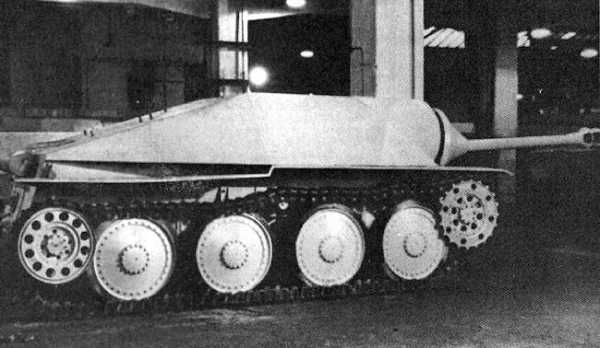
Wooden mock-up of the Jagdpanzer 39(t) Hetzer with muzzle brake.
Production
On 18 January 1944, Hitler signed an order for the production of 1000 vehicles even before the final blueprints were delivered. A very optimistic schedule was defined, which required growing production capacity from BMM and, later, Škoda, revving up from 20 vehicles in April, to 200 in July and 500 in March 1945. It should be noted that, together, the factories never delivered as much as 300 vehicles monthly. The maximal output was performed by BMM, 155 in a month.
Another G13 modified to look like a Hetzer on display at the HMG Wheels and Tracks exhibition, Vienna, 2010.
Nevertheless, the first production Hetzers were delivered in March 1944, as scheduled, and accepted by the Waffenamt in early April. The first 20 were demonstrated in front of Hitler on April, 20. However, production goals were significantly hampered by the delivery of the gun mounts. There were a few corrections to be made also, quickly detected in the first batches: leaking gaskets, deficient air filtration, carburetors, governor, incorrect spark plug types and the layout of the connecting lines between the fuel tanks.
Design
Despite its appearance, the Hetzer was not built directly over the Panzer 38(t) chassis. The latter had to be widened and lengthened in order to support the weight of the casemate, and had modified suspensions with an up-rated engine. It had the same combination of large roadwheels and improved leaf spring suspensions units (two pairs), but only one return roller per side. The drive sprockets were at the front and idlers at the rear. The latter were later simplified, with six drilled holes, although most of the production vehicles used the standard model.
Details up close, rear.
Mobility
The engine was the new 160 hp@2,800 rpm (118 kW) Praga AC/2 6-cylinder, connected to a Praga-Wilson gearbox with 5 forward and 1 reverse gears. Along with the reinforced suspension, in order to cope with the weight of the new 75 mm (2.95 in) gun, this engine compensated for the overall weight increase, which went from 9.5 tonnes on the original light tank to the 15.7 tonnes of a Hetzer in battle order. Top speed was apparently still 42 km/h (26 km/h), which appears optimistic, since the power to weight ratio fell to only 10 hp/tonne, compared to 13.15 hp/tonne on the Panzer 38(t). Cross-country speed was probably no more than 15 km/h (9 mph) at best, like the model it was based on. It was far short from the original specifications.
Protection
In terms of protection, the big advantage of the Hetzer was its highly sloped casemate, with a 60 mm (2.36 in) thick plate on the front, which was inclined 60 degrees from the vertical, and therefore offered around 120 mm (4.72 in) of effective protection. Needless to say, Allied tank guns had a hard time penetrating it, except for the fabled British 17-pounder. The lower part of the hull was still of the same thickness and sloped (hardened steel E22), but the sides were only 20 mm (0.79 in) thick and made of low quality alloy, but inclined at 40°. The roof was only made of an 8 mm (0.31 in) thick plate, proof only against shrapnel. The belly was 10 mm (0.39 in) thick.
Accommodation and crew
Due to the limited area defined by the narrow chassis/hull width and highly sloped casemate, internal space was very cramped. The driver, gunner and loader were all placed on the left side, in a row. The only escape hatch there was a small trap below the loader, barely accessible by the two others. Due to the main gun being positioned on the far right of the hull, the loader had to work in an awkward position, which was not practical and obliged him to reach under or across the gun and into the recoil path of the gun in order to access the safety lock or the ammunition, whereas the commander, installed in a niche at the rear, was cutoff from the others.
Vision was generally poor, there were twin periscopes of the driver in the front plate (it was later discovered they formed a shot trap), the main slf ZF sight for the gunner, a periscopic sight for the machine-gun, another for the loader, plus the SF14Z scissors periscope for the commander. The vehicle was literally blind on the right side, which was especially problematic since protection there was minimal. Attempts to correct this with a fully traversing periscope (Starr) for the commander never took place.
Tooling stowage was external and comprised a jack, jack wooden block and wire cutter stowed on the right track guard and wrecking bar on the left. 8 spare track links were often attached on the rear deck, while 6 others and two towing cables were fastened on the rear back plate.
Jagdpanzer 38(t) Hetzer crossing a village next to loaded horses/mules, KBZ Army Group South, Ukraine
Modifications
The first series was equipped with horizontal mufflers and standard twelve hole idler wheels. They also featured a narrow main gun mantlet and flat plate side armor skirts hooked on welded brackets. Also, on the earliest vehicles, both fuel tanks were filled via the same fuel port, located on the left side. This was among the first things corrected, but the main problem was the Hetzer was critically nose heavy (which is why it never received a muzzle brake).
Fixes during production
– Modified exhausts with a vertically oriented tube and flame arrester (replacing the muffler)
– Wider mantlet for the main gun (to give slightly more traverse), but lighter
– Improved elevation/traverse mechanisms
– Inwards angled side skirt corners (to avoid snagging vegetation)
– Better filler port
– Gratings over the air intake openings (to avoid vegetation being sucked into the engine compartment)
– Mechanical pump (instead of electrical)
– Riveted road wheels instead of boltened (and later welded).
– Strengthened leaf spring suspension packs (9 mm thick leaf bands)
– Improved heating arrangements in the fighting compartment (winter batteries)
– Double arm mount for the commander’s own observation telescope, hatch in two pieces
– Better ammo storage (for five more rounds)
– Hand grips welded on the ceiling of the fighting compartment over the driver’s seat
– Better final drive assemblies
– New simplified idler wheel with 10, 6 or 4 drilled lightening holes.
Variants
Hetzer “Starr”
The Starr was characterized by a rigid mount for the main gun. It was tailored for simplified mass-production, and therefore the gun recoil system was entirely eliminated. The recoil had to be absorbed by the chassis and suspensions. Aiming was entirely performed by the same transmission, but coupled to a new Tatra 8 cylinder diesel engine in development. Also, in order to cope with poor vision, the commander received a rotating periscope. Ultimately 10 were built, but later seven were converted back as standard Hetzers after the war because the Starr tubes had worn out. The Jagdpanzer 38 Starr was also meant to receive later a longer L/70 gun, but it came too late to see action.
Jagdpanzer 38(d)
This final, transitional version had a wider hull, better side protection (50 mm/1.97 in), same rigid gun mount as the Starr, but with the L/70 gun, and the new 8-cyl Tatra engine. It was an even simpler version of the Starr and another step towards the planned E 10. At least 10,000 were expected to have been produced by BMM before the fall of 1945.
Flammpanzer 38(t)
The German army needed more flame-throwing tanks for their December 1944 winter offensive in Ardennes, Operation Watch on the Rhine and the Operation North Wind in Rhineland-Palatinate, Alsace and Lorraine. Twenty Jagdpanzer 38(t) tank hunter chassis were fitted with a 14 mm Flammenwerfer flamethrower gun, instead of its normal 7.5cm PaK 39 anti-tank gun. A tube was installed on the front of the flamethrower to make the vehicle look like the standard Jagdpanzer 38(t) in an effort to confuse the enemy.
Bergepanzer 38(t)
A light recovery vehicle created especially for the Hetzer and light vehicles of its class. Between 64 and 106 (even 120) were converted until the end of the war (chassis numbers 321001-323000-323001), equipped with jack handbars, winch, steel cables, wooden support planks and a rear hydraulic leg for a better grip. Its only armament was a single 7.92 mm (0.31 in) Rheinmetall MG 34 or 42 mounted on the front arm.
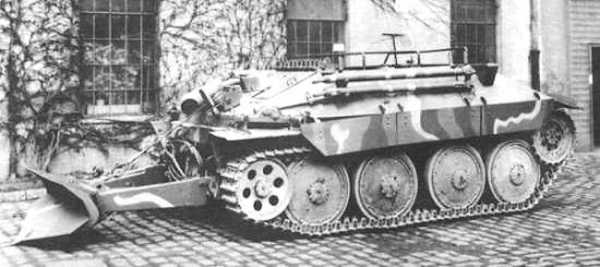
Panzer 38(t) variant the Bergepanzer 38(t) with dozer blade deployed
Befehlspanzer 38(t)
The standard command variant. Nothing really special except for a 30W FuG 8 radio set and extra whip antennas. It was still armed the same way as regular Hetzers, making it even more cramped inside.
Jagdpanzer 38(t) of 8th SS Cavalry Division Florian Geyer, Hungary, 1944 – Credits: Bundesarchiv.
Bergepanzer 38(t) mit 30 mm MK 103 autocannon anti-aircraft gun
A number of Bergepanzer 38(t) light armoured recovery vehicles were converted into anti-aircraft flakpanzers. They were fitted with a 30 mm Rheinmetall-Borsig MK 103 autocannon. The letters MK are an abbreviation for the word ‘Maschinenkanone’.
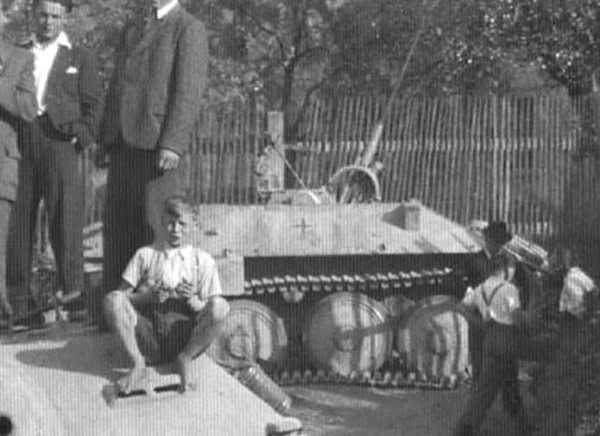
In the background you can see a Bergepanzer 38(t) mit 30 mm MK 103 autocannon anti-aircraft gun with its gun raised.
This weapon was originally designed to be mounted in German combat aircraft and intended to have a dual purpose as an anti-tank and air-to-air fighting weapon. This gun was also used on the five prototype Flakpanzer IV “Kugelblitz. If necessary the gun could also be used in a ground support roll against enemy troops and vehicles.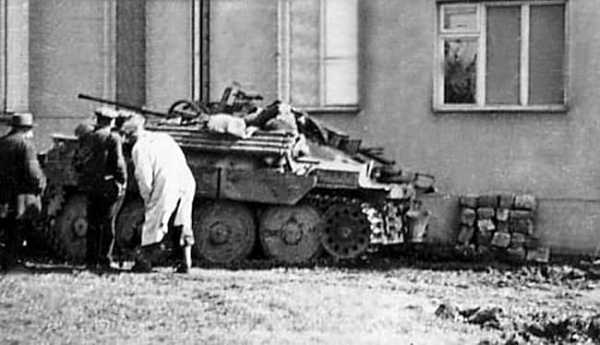 A Bergepanzer 38(t) mit 30 mm MK 103 autocannon anti-aircraft gun
A Bergepanzer 38(t) mit 30 mm MK 103 autocannon anti-aircraft gun
Other experimental variants
The most daring propositions were a model of assault gun with a 105 mm (4.13 in) StuH 42 or a 120 mm (4.72 in) mortar for infantry support. Another “long” version was given the 7.5 cm KwK 42 L/70 gun from the Panther. There was also an AA variant with a 20 mm (0.79 in) KwK 38 Flak turret. The war ended before any of these were put into production.
Waffentraeger Krupp-Ardelt: 88 mm (3.46 in) PaK 43 tank hunter which borrowed the suspension and roadwheels from the Hetzer. One real size mockup built (July 1944). Production was expected to start in October, but the program cancelled.
12.8 cm Waffentraeger 38(d): Was meant to use the lengthened and strengthened Panzer 38(d) chassis.
Vollkettenaufklarer 38(t) (Kätzchen): A reconnaissance APC/IFV heavily tested, but never produced. Several prototypes of the regular model armed with 1 or 2 2cm Flak 38 guns and several of the Kätzchen APC were built and tested in late 1944.
Flakpanzer 38(t) Kugelblitz: A proposition to mount the twin Flak turret from the Panzer IV Kugelblitz on the Jagdpanzer 38(t) chassis.
Panzerkampfwagen 38(t) mit 7.5cm KwK L/48 (Pzkpfw IV) Turm: A reamed Panzer 38(t) (reinforced and stretched out) armed with the Panzer IV turret.
7.5 cm Stu.Kan. auf Pz.Kpfw. 38(t): Tank hunter prototype (one photo), possibly used on the Eastern front (Panzer Tracts No. 7-2)
The Hetzer in action
It was originally planned to test the vehicle as early as April 1944, but delays ensured the first batch of Jagdpanzer 38(t)s reached the ordnance depot in May. They were tested by Wa Prüf 2 and joined training groups in the summer, until July. The first 45 entered service with the Heeres Panzerjäger-Abteilung 731 on 4-13 July 1944 (Army Group North, Eastern Front, later Mitte). One of the first engagement occurred in Warsaw in August 1944, during the famous uprising. At least one was captured, renamed and restored by Partisans, but never used (“Chwat”).
Other units that received it were the 741st (September), 561st (January 1945) and 744th (February). The 741st was eventually split in two, one half being shipped to the Western Front for operation Wacht am Rhein. They were organically attached to infantry divisions and issued to Jäger, Kavalerie and Grenadiers corps within the infantry, rather than independent units. By late 1944, each company was given 14 Hetzers, but, after February 1945, this number fell to 10.
In the Ardennes, no less than 18 companies participated in the offensive (295 in all). On 30 December, only 131 were reported operational. Other independent units also received Hetzers instead of other, more powerful, tank hunters, mostly due to production delays, namely the 16th SS Panzergrenadier Division, the Abteilung Jüteborg and Schliesen, FHH PZd and PZGd, even the StuG Brigade 266. There was also plans to deliver these to Allies, but while Romania never received a single one, Hungary got 75, which arrived by train between December 1944 and January 1945. They fought in support of Heeresgruppe Sud.
An interesting experiment began with the the constitution of the mixed independent Pz.Jagd.Brigade 104 as a hunter-killer unit on the Eastern Front, but it was short lived. The tank hunters were scattered around in order to plug holes in depleted units all along the Eastern Front. By March 1945, only 359 Hetzers were reported operational, out of 529 still in the registry.
From German reports, kill/loss ratios were excellent. Early on, one of the first units engaged claimed 20 kills with no loss. Another unit, also on the Eastern front, reported 57 kills without losses, engaging IS-2s at 800 m (880 yd) and more. It was also reported that the whole unit reached its objective, 160 km (100 mi) from its base, without a single breakdown en route. Crews were also delighted by the frontal protection and remote “Rundumsfeuer” machine gun.
Little known, however, were the Hetzers deployed in Northern Italy. Four companies operated 56 Hetzers there in 1945. At the same date, they reported only 37 operational Panzerjagers, while only 137 were still enlisted on the Western front. This was, noticeably, one of the highest operational percentage of all German tanks units. Later in the war, however, officer mismanagement of the Hetzer and poor training took their toll on units.
Abandoned Hetzer inspected by US troops, Belgium, winter 1944-45.
Generally speaking, the Hetzer was a good generic tank hunter. It was well armed and well protected from the front, presenting a small silhouette and narrow target. It could be concealed quite easily and was difficult to spot even after firing and, crucially, was also very reliable. However, it had shortcomings too, that were only partially compensated by its great availability. From 1944 and until the end of the war, it became the most current German tank hunter, not counting the heavier StuG III. In October 1944, Wa Prüf 1’s report on penetration values showed that it could be defeated by the Cromwell’s and Churchill’s 75 mm (2.95 in) gun from up to 2500 to 3600 m (1.5-2 mi) from the sides and rear. However, it could be penetrated by the late M4 76(W) Sherman’s M1A1 gun from 800 m (880 yd) from the front and from closer than 100 m (110 yd) through the cast mantlet. But it could defeat most versions of the M4, Cromwell and Churchill at any angle from as much as 1,700-1,800 m (1900-2000 yd).
The Hetzer was also slow and completely blind from the right side, which was a liability in urban combat. Many were captured this way and it was never really corrected.
Hetzer stuck at a barricade, Warsaw Uprising, August 1944.
Soviet Army capture the factories
When the Red Army liberated Czechoslovakia they conducted a stock take of what was in production at the Škoda factories at the time they came under ‘new management’. A report was filed on the possibility of completing the vehicles found at Škoda factories. The auditor found 1,200 unfinished Jagdpanzer 38(t) tank-destroyers “G-13” chassis. It was worked out that 150 of them could be finished from the parts available. The remaining 1,050 vehicles were 45%-60% percent completed and had only 78 main guns available between them. This report showed that production of the Hetzer chassis was outstripping the manufacturing capacity to build the main gun in sufficient quantities.
Other operators
Swiss G13
After the war, Switzerland obtained from Czechoslovakia no less than 158 post-war built Praga ST-II/III, and, after extensive modifications, they were renamed G13. Differences included the muzzle brake fitted on the main gun, loader and commander positions swapped, rotating MG optics (commander’s cupola) and external MG mount on the rear deck. About two thirds received a Swiss Saurer diesel engine in 1952-53 and the vehicles were maintained in service until 1970. After being phased out, most were purchased by museums and private collectors, mostly converted/painted back as German Jagdpanzer 38(t) Hetzers. At least four are in running conditions today.
Czechoslovakian ST-1
The Czech Jagdpanzer 38(t) Hetzers (several dozens were captured in and around Budapest in 1945) were designated ST-1, for Stihac Tanku or “Tank Hunter”. 249 were pressed into service. There was also a school driver version designated ST-III/CVP (50 vehicles), the Praga VT-III armored recovery vehicle and the PM-1 flamethrower tank. 50 existing Hetzers were to be modified with a flame thrower turret, but the program was cancelled.

During the Prague uprising 5th-9th May 1945 freedom fighters captured this German Jagdpanzer 38(t) Hetzer. It did not have a gun fitted but in its place it was armed with a German anti-tank Panzerfaust. (photo capture taken from the film called ‘Květnová revoluce v Praze 1945’ held in the Národní filmový archive)
Romanian Mareșal, 1943.
Jagdpanzer 38(t), the first command model built with Fgst.nr.321001 radio.
Jagdpanzer 38(t) “Chwat” (Daredevil) captured by Polish insurgents. An early production tank, Warsaw, August 1944.
Hungarian early type Jagdpanzer 38(t), 1944.
Early type Jagdpanzer 38(t) “Black 233”, western front, one of the earliest captured by the Allies.
Hungarian Jagdpanzer 38(t), winter 1944-45.
Hungarian Hetzer, 1944.
Hungarian Hetzer, 1945.
Unknown unit, Bohemia, spring 1945.
Jagdpanzer 38(t) of the 11th SS Panzerdivision “Nordland”, winter 1944-45.
Jagdpanzer 38(t) with the spotted ambush camouflage, Germany, April-May 1945.
Czech Hetzer, in service by May 1945 with the Russian Liberation Army (Русская освободительная армия)
Hungarian Jagdpanzer 38(t) “Mokus” tank destroyer, Lake Balaton battle, 1945.
Hetzer captured by the Russian army, Czechoslovakia, 1945.
Jagdpanzer 38(t) Hetzer of an unknown Panzerjäger unit in Italy, 1945
Hetzer captured by Czech insurgents, Prague, May 1945.
Bulgarian Jagdpanzer 38(t), March 1945.
Unknown unit, ambush camouflage, Germany, April-May 1945
Unknown unit, Bohemia, 1945.
Variants
Befehlspanzerjäger 38(t), 741st Antitank Battalion, Eastern Front, 1944.
Flammpanzer 38(t), 352nd Panzer-Flamm-Kompanie, Army Group G, Belgium, December 1944.
Jagdpanzer 38(t) Starr (1945). Being rather disappointing, the six built of this much simplified versions were converted back as regular Hetzers.
Panzerjäger 38(t) mit 75 mm L/70.
Swiss G13 in 1960, notice the spare roadwheel should be on the other side. For identification only.
Derivatives
Bergepanzer 38(t).
Another, more common type of Aufklärungspanzer mit 7,5 cm KwK-37 L/23.
Rare Jagdpanzer 38(t) mit 7,5 cm KwK-37 L/23, Battle of the Bulge, winter 1944-1945.
Vollkettenaufklärer 38(t) prototype.
Was it called the ‘Hetzer’ during WW2?
It is often stated that first use of the name Hetzer was in a letter from Heinz Guderian to Hitler. In it he stated that the name had spontaneously arisen from the crews manning the vehicles. This is what most historians base their naming on in their works, and state that the vehicle was never identified as such in official German Military documents. That last part is NOT true. Look at this wartime report dated April 1945 the word Hetzer is used.

In the eighth line down you will see the entry Jg.Pz 38 t Hetzer. It is strange why this SS Officer listed one Jg.Pz.38t in short term repair as a “Hetzer”, but later listed ten Jagdpanzer 38(t) SPGs as just Jg.Pz.38t and did not include the name. Seven of those ten are shown as operational, one in short term repair and one in long term repair. (Source German Archives)
In a monthly HWA report on German weapons in early 1944 it was called StuG n.A. mit 7.5 cm Pak 39 L/48 auf Fgst Pz.Kpf. Wg 38(t) (StuG n.A. = Sturmgeschütz neuer Art – assault gun new version). The German term ‘neuer Art’ is exclusively used during design, it was not used for a production vehicles. It does not get called the usual Jagdpanzer 38 mit 7.5 cm Pak 39 L/48 auf (Sd.Kfz.138/2) until November 44.
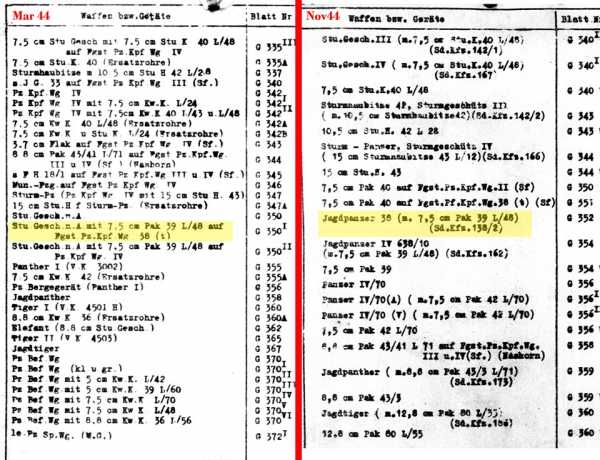
Monthly HWA reports on German weapons in March 1944 and November 1944. (Steven Zaloga)
To summarise, the Jagdpanzer 38(t) was not officially called the Hetzer during WW2. It is believed that the crews used this nickname for this anti-tank self-propelled gun during the war. Although most official wartime documents do not use the word Hetzer, as can be seen in the first of the two documents, a few did.
Did the Jagdpanzer 38(t) Hetzer have a muzzle brake?
The answer is yes, no, then yes. A muzzle brake is designed to increase the life expectancy of a gun barrel by direction some of the explosive force of the shell gasses side ways rather than just forward. The wooden mock up of the prototype was fitted with a muzzle brake. The early production Jagdpanzer 38(t) Hetzer’s were fitted with a muzzle brake but these were removed by crews and later production vehicles did not have them fitted. It was found they produced too much dust and smoke which gave away their ambush position. This was often fatal. The post war Swiss G-13 version had a muzzle brake fitted.
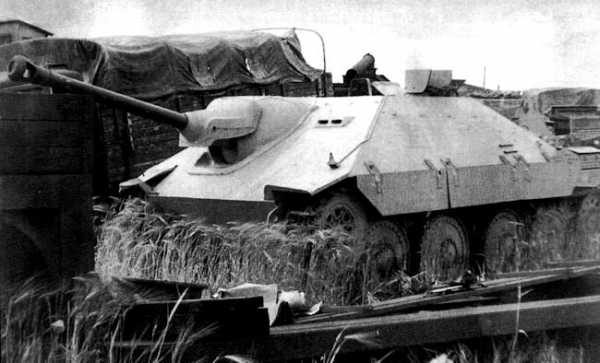 Early production Jagdpanzer 38(t) Hetzer with muzzle brake.
Early production Jagdpanzer 38(t) Hetzer with muzzle brake.
The G-13 name
G-13 – It is just the internal manufacturer’s code name for the Jagdpanzer 38(t) in the Skoda Factory. A WW2 wartime Skoda Jagdpanzer 38(t) Hetzer was called a G-13 in the factory and on all internal documentation.
G = tank destroyer, 1 = light, 3 = model i.e number 3.
G-11 was Panzerjaeger I,
G-12 was Marder III.
Postwar – the 75 mm PaK 40 with a muzzel brake was used instead of the 75mm PaK 39 on Jagdpanzer 38 (t). The Skoda Factory did not have access to PaK 39 guns and used the PaK 40. In the Swiss Army this tank destroyer was known by the factory code G-13 rather than the Jagdpanzer 38(t) or Hetzer name.
Gallery
A ST-I tank destroyer, practically a Czech post-war production Hetzer, in running condition at an exhibition at Lešany, Czech Republic.
Swiss G13, Steel Parade, 2006. The G13 was kept in service right into the 1970s.
Video about German assault guns
Jagdpanzer 38(t) specifications | |
| Dimensions (L W H) | 4.83m (without gun) x 2.59m x 1.87 m (15’10” x 8’6″ x 6’1″ ft.in) |
| Total weight, battle ready | 15.75 metric tonnes (34,722 lbs) |
| Armament | 75 mm (2.95 in) PaK 39 L/48, 41 rounds 7.92 mm (0.31 in) MG 34, 1,200 rounds |
| Armor | 8 to 60 mm (0.3 – 2.36 in) |
| Crew | 4 (driver, commander, gunner, loader) |
| Propulsion | Praga 6-cyl gas. 160 hp@2,800 rpm (118 kW), 10 hp/t |
| Speed | 42 km/h (26 mph) |
| Suspension | Leaf springs |
| Range | 177 km (110 mi), 320 l |
| Total production | 2,827 |
Links and resources about the Hetzer
The Hetzer on Wikipedia
Pfahrer, Swiss website about the Hetzer
Article about the Hetzer Starr
The Hetzer on Achtung Panzer
The Shadocks – Surviving Hetzer/G13s (pdf)
Osprey New Vanguard: The Jagdpanzer 38(t) (Doyle/Jentz/Badrocke)
Panzer Tracts 7-3, Panzerjägers (Doyle/Jentz)
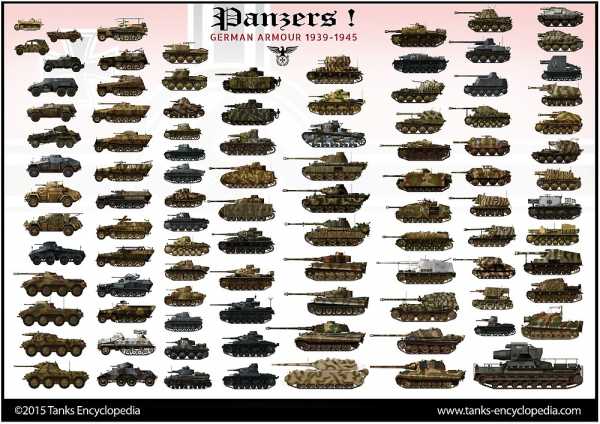
Germans Tanks of ww2
www.tanks-encyclopedia.com
